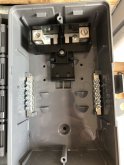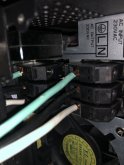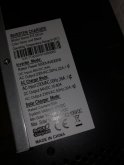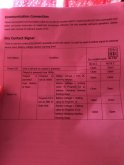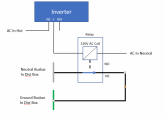I have the following inverter. 5kva hybrid 48vpure sine wave inverter with charge controller.
In my camper, the system is off grid. Using solar panels (2-315w) and a 4-100ah 12v batteries ran in series. No other power source, as Colorado is always sunny. The inverter does have an AC input to plug
into a outlet if I wanted to charge the batteries that way, but it is not a necessity to me.
It’s the 5kva, 48v. Model. It has 3 wires as the AC output of 230v. It lists the 3 outputs as ground, leg or hot, and neutral. But I tested the wires. And the hot is 117v, and the neutral is 113v. Testing that both are a 110v hot?
I am trying to run this into a electrical panel, and run my trailer camper with receptacles At 110v. Maybe just 2 breakers is all I need to run a few lights, 5 outlets,
I am Trying to figure out if the neutral is actually a hot, how do I hook it up? Do I ru. The 2 hits into separate circuit breakers, connect all the grounds to the left bus bar, and ground it to the chassis. And not use a neutral? If it doesn’t actually have a neutral output, does that mean it has an internal Neutral, and I should bond my neutral to ground? Or should I connect all the neutrals on the right bar, and then run it to the AC input neutral or hot, and make a loop so any overpower returns to the inverter? I am really confused by the neutral situation. I don’t want to screw anything up and fry myself or the system. Any advice would be greatly appreciated in advance!!
the manual doesn’t say anything about this, and I’m having trouble finding anything online.
Help!!!! ?
it does have a option in the display to have internal neutral ground bond enables or disabled.
In my camper, the system is off grid. Using solar panels (2-315w) and a 4-100ah 12v batteries ran in series. No other power source, as Colorado is always sunny. The inverter does have an AC input to plug
into a outlet if I wanted to charge the batteries that way, but it is not a necessity to me.
It’s the 5kva, 48v. Model. It has 3 wires as the AC output of 230v. It lists the 3 outputs as ground, leg or hot, and neutral. But I tested the wires. And the hot is 117v, and the neutral is 113v. Testing that both are a 110v hot?
I am trying to run this into a electrical panel, and run my trailer camper with receptacles At 110v. Maybe just 2 breakers is all I need to run a few lights, 5 outlets,
I am Trying to figure out if the neutral is actually a hot, how do I hook it up? Do I ru. The 2 hits into separate circuit breakers, connect all the grounds to the left bus bar, and ground it to the chassis. And not use a neutral? If it doesn’t actually have a neutral output, does that mean it has an internal Neutral, and I should bond my neutral to ground? Or should I connect all the neutrals on the right bar, and then run it to the AC input neutral or hot, and make a loop so any overpower returns to the inverter? I am really confused by the neutral situation. I don’t want to screw anything up and fry myself or the system. Any advice would be greatly appreciated in advance!!
the manual doesn’t say anything about this, and I’m having trouble finding anything online.
Help!!!! ?
it does have a option in the display to have internal neutral ground bond enables or disabled.




